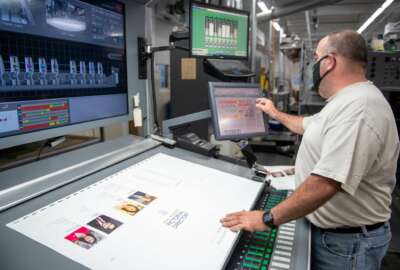

Mass telework occurred overnight. But policies for post-pandemic telework could take months longer.
When I hear some politician tout something as “common sense,” I instinctively grab my right rear tuchus to protect my wallet.
Yet common sense is a quality that exists in real life. I went bowling last night for the first time in 15 years. I lack bowling skill, to put it mildly. But a piece of sports common sense dawned on me in the second string. Namely, look down the lane at the pins as you release the ball. Bowling balls, footballs, fishing flies, javelins, motorcycles — they all go where your eyes go. Common sense. I didn’t bowl any strikes but I at least rolled a 3-digit score.
And it was common sense that led Government Publishing Office Director Hugh Halpern to establish a post-pandemic telework policy while much of the government dithers and wrings its hands in worried policy anxiety.
I know, I know. The White House did release a detailed memorandum giving agencies until this Monday to come up with their plans for reentry and what it oddly calls “post-reentry” of employees or contractors. It calls for telework and remote work, along with flexible work schedules, as “strategic management tools” for the government to be a competitive employer.
So if I stand in L’Enfant Plaza in Washington, D.C. on Tuesday, and ask a few random federal employees who are already traipsing into the office ‘what is your telework policy,’ would they be able to answer definitively?
GPO is a congressional, not an executive branch, agency. So it could move at its own pace. Halpern is a former congressional staff member. He says that he consulted with GPO’s overseers but that the discretion to issue the new policy was his. But he used common sense and basically simple reasoning to arrive at it.
“All of our telework-capable folks really stepped up, and increased productivity,” he told me. “If you’re doing something that works and works well, we need to do more of that.” He said the policy is all about taking the measures that worked during the pandemic, “and embracing them.”
Workgroups still need to consult with supervisors, but the default now is to allow telework, versus what Halpern called “grudging” allowance earlier. GPO’s chief human capital officer, Dan Mielke, said that one small work group of 17 people has already chosen to go telework 100%. His own HR staff will operate hybrid.
And that’s it — a simple policy but one way different from before. It only applies to about a third of GPO’s 1,500 employees. The rest have to stay in the buildings where GPO still prints, duplicates, binds and otherwise produces physical things on machinery. It may or may not be the correct policy for your agency, but the point is, at least one agency has established a policy. Too many others are still cogitating and, I worry, getting lost in nuanced complexity.
Some agency chiefs are apparently in no hurry. Just yesterday, the Equal Employment Opportunity Commission said it would seek input from citizens regarding returning to in-person work. It set up a comment platform so people can tell how they’ve interacted with EEOC, whether they liked online sessions. There’s even a question of whether people would like to see more EEOC offices scattered around the country. Hmmm. I wonder where they’re going with that one.
We’ll see what Monday actually brings in terms of plans and policies. In the meantime, if you think you’ll be working from home for a while and you’re too used to slouchy clothes, borrow a strategy from Curtis Mejeur. He works at the Office of Personnel Management as an advisor to the director on technology. Interviewing him on another matter via Zoom, I saw him in a very nice home office, clad in dress shirt and necktie.
I asked, what gives? I got a solid, common sense answer. He said the outfit signals his young children that even though he’s home, he’s at work, so mind the boundary. And, Mejeur told me, when he changes at the end of the day, it signals to him a personal boundary crossing, that work is over.
As for policy development, that work never ends.
The “most extreme toilet in the world,” according to a survey conducted by the Interfax news agency in Belarus, sits on the edge of a cliff 2,600 meters above sea level. It’s the only toilet for a five-person weather station in the Altai mountains in Siberia.
Source: Siberian Times
Copyright © 2025 Federal News Network. All rights reserved. This website is not intended for users located within the European Economic Area.
Tom Temin is host of the Federal Drive and has been providing insight on federal technology and management issues for more than 30 years.
Follow @tteminWFED


